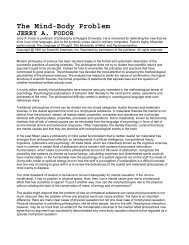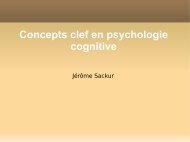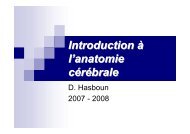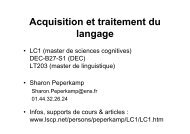From single to multiple deficit models of developmental disorders
From single to multiple deficit models of developmental disorders
From single to multiple deficit models of developmental disorders
You also want an ePaper? Increase the reach of your titles
YUMPU automatically turns print PDFs into web optimized ePapers that Google loves.
388 B.F. Penning<strong>to</strong>n / Cognition 101 (2006) 385–413<br />
each multifac<strong>to</strong>r were jointly necessary <strong>to</strong> produce a disorder, then probability theory<br />
dictated a mathematical limit <strong>to</strong> the number <strong>of</strong> possible multifac<strong>to</strong>rs involved in<br />
a common disorder. For instance, if Wve multifac<strong>to</strong>rs were involved, each with a population<br />
frequency <strong>of</strong> 30%, then the probability <strong>of</strong> having the disorder (2.4 per thousand)<br />
would be much lower than the roughly 5–10% prevalence <strong>of</strong> <strong>disorders</strong> like<br />
dyslexia or ADHD. But they did not consider a <strong>multiple</strong> deWcit model in which the<br />
cognitive risk fac<strong>to</strong>rs are neither necessary nor suYcient, which consequently would<br />
not face this mathematical problem. That is the <strong>multiple</strong> deWcit model that is developed<br />
later in this paper, which can be thought <strong>of</strong> as a form <strong>of</strong> the many-<strong>to</strong>-many<br />
mapping model, but with diVerent weights across the paths between levels <strong>of</strong> analysis.<br />
They also attempted <strong>to</strong> deal with the complexity posed by the <strong>of</strong>ten numerous<br />
behavioral symp<strong>to</strong>ms found in <strong>developmental</strong> <strong>disorders</strong> by parsing symp<strong>to</strong>ms in<strong>to</strong><br />
those that were primary (direct eVects <strong>of</strong> the <strong>single</strong> cognitive deWcit), secondary<br />
(symp<strong>to</strong>ms caused by the primary symp<strong>to</strong>ms), correlated (produced by the eVects <strong>of</strong><br />
the etiology <strong>of</strong> primary symp<strong>to</strong>ms on other brain systems), and artifactual (symp<strong>to</strong>ms<br />
not causally related <strong>to</strong> the etiology or pathogenesis <strong>of</strong> the disorder but associated<br />
because <strong>of</strong> referral biases).<br />
They concluded by making a plea for parsimony: that the simpler <strong>single</strong> cognitive<br />
deWcit model should be considered Wrst. As we will see, now nearly 15 years later, the<br />
simple <strong>single</strong> cognitive deWcit model has been much more thoroughly tested and its<br />
shortcomings are now much more evident.<br />
As I will explain in the rest <strong>of</strong> this paper, there are several key reasons for rejecting<br />
this very simple <strong>single</strong> cognitive deWcit model: (1) behaviorally deWned <strong>developmental</strong><br />
<strong>disorders</strong>, like dyslexia or ADHD, do not have <strong>single</strong> causes, either at the etiologic or<br />
cognitive levels <strong>of</strong> analysis, (2) such <strong>disorders</strong>, instead <strong>of</strong> being independent, are frequently<br />
comorbid and this comorbidity is due <strong>to</strong> partly shared genetic and cognitive<br />
risk fac<strong>to</strong>rs, and (3) there are other problems with applying double dissociation logic<br />
<strong>to</strong> <strong>developmental</strong> <strong>disorders</strong>, which will be discussed at the end <strong>of</strong> the paper. Because<br />
<strong>of</strong> the key role that research on comorbidity played in the evolution <strong>of</strong> my thinking, I<br />
will begin with an exploration <strong>of</strong> how I attempted <strong>to</strong> use the <strong>single</strong> cognitive deWcit<br />
model <strong>to</strong> account for comorbidity.<br />
3. Can the <strong>single</strong> cognitive deWcit model account for comorbidity?<br />
For more than a decade, we have been studying two comorbidities <strong>of</strong> RD, that<br />
with ADHD and that with speech sound disorder (SSD). What we have found poses<br />
signiWcant challenges for the <strong>single</strong> cognitive deWcit model.<br />
Comorbidity is an important <strong>to</strong>pic in both child (Angold, Costello, & Erkanli,<br />
1999; Caron & Rutter, 1991) and adult (Clark, Watson, & Reynolds, 1995) psychiatry,<br />
partly because it poses challenges for how we categorize <strong>disorders</strong> and think<br />
about their causes. One <strong>of</strong> the most comprehensive treatments <strong>of</strong> diVerent possible<br />
reasons for comorbidity was provided by Klein and Riso (1993). Neale and Kendler<br />
(1995) used quantitative genetic theory <strong>to</strong> more precisely specify the Klein and Riso<br />
(1993) comorbidity <strong>models</strong>. These <strong>models</strong> cover both artifactual (chance, sampling







